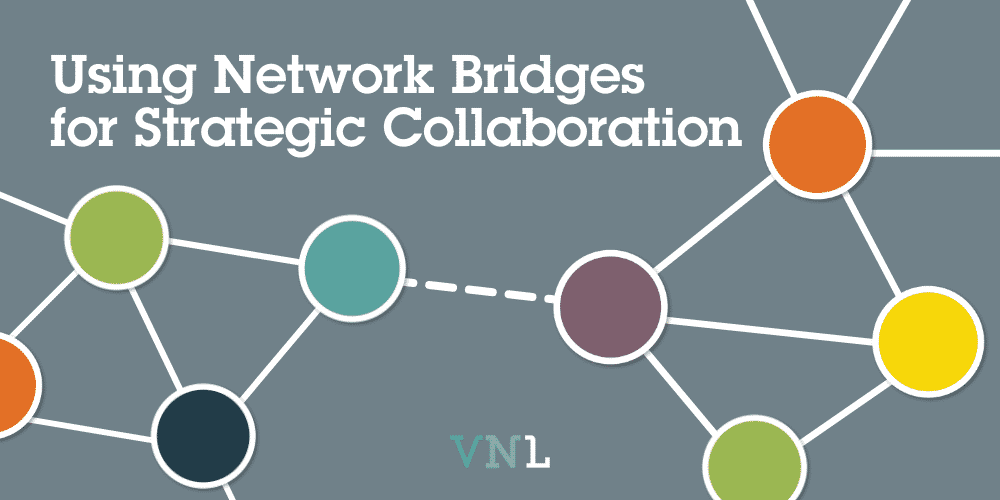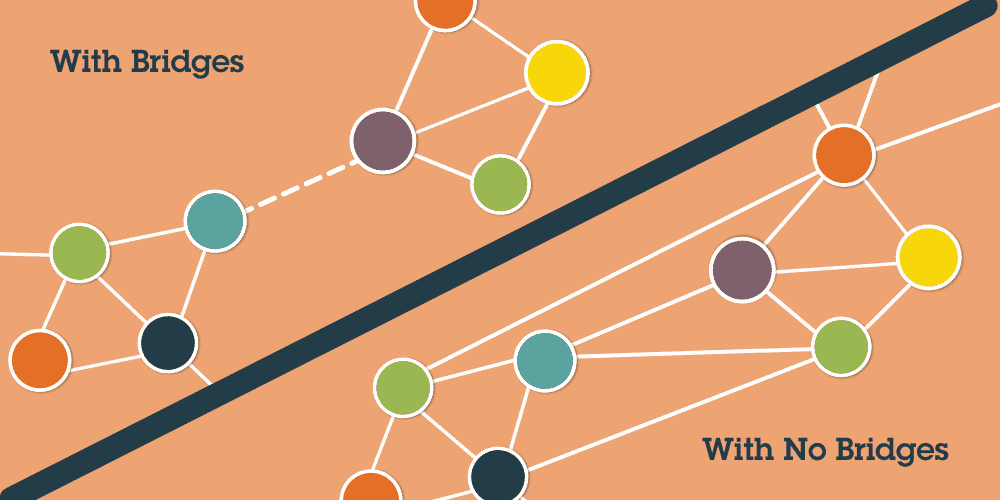
Using Network Bridges for Strategic Collaboration
It’s more and more common for people working towards social impact to build and work in networks to reach their shared goals. By sharing information and resources, coordinating their activity, and collectively measuring their impact, a network can accomplish far more than a single individual or organization working towards social change. However, working in a network is not always easy. Many networks quickly grow large and complex, making it difficult to know if your collaboration is working or not. Using network bridges, a concept from network science can help you build more strategic and effective networks for collaboration.
What is a Network Bridge?
A network bridge is an individual or organization that connects two separate groups. They help ensure the flow of ideas and resources in a network is efficient by connecting disparate sub-groups. A network bridge can play a role formally as a liaison between groups or informally fill this role in more organic development. Network bridges are a key structural element for building smarter, more strategic networks for collaboration, with many benefits.
The Benefits of Network Bridges
Network bridges help regulate flows in a network of all different kinds, making them particularly useful for reaching your strategic objectives. They can play an important gatekeeper role, helping manage information to share key details with network sub-groups without overwhelming them with too much. Network bridges also increase the diversity of a network, allowing network leaders to connect indirectly with hard-to-reach individuals or groups that the network bridge may know closely. Instead of having to connect to all members of a network, bridges allow you to maintain just a handful of ties that in term remain connected to many others, saving you time and resources for additional collaboration.

Tips for Using Network Bridges
Any group of partners can benefit from using network bridges in the structure of their network. First, try to identify the natural sub-groups that exist in your network. This could be pre-existing groups of partners that have joined the network, or informal groupings of partners that know and work together closely. Next, you need to identify a member of each group to serve as a network bridge. It’s important to pick a group or individual with a strong relationship, so you can still leverage their ties when needed. The ideal network bridge is respected by their partners, with a knack for making connections and sharing information with others. They’re usually natural networkers!
Social Network Analysis: A Helpful Tool for Using Network Bridges
It’s very difficult to use network bridges if you don’t know what your network structure looks like in the first place. Social network analysis can help you collect data about your network connections so you can visualize them. This makes identifying network sub-groups and bridges much easier than working in the dark. PARTNER is our powerful platform for tracking your network over time to measure and drive your impact. Click here to learn more about how it works, and how it can help with using network bridges.
Using Network Bridges: Now You Know!
Building and leading a network of partners is no easy task, but network bridges are a great tool to make it a bit easier to share resources and information and manage your complexity. To start using network bridges, identify the sub-groups in your network and the best group or person to connect you to each. Social network analysis with a tool like PARTNER are very helpful for visualizing your connections to make this identification quick and easy. Now that you know the basic about using network bridges, you’re ready to start building smarter, more strategic networks. Best of luck on your network journey!




